Home · Book Reports · 2018 · Chronology 1 - History - Fiction or Science?

- Author :: Anatoly T. Fomenko
- Publication Year :: 2004
- Read Date :: 2018-02-12
- Source :: Chronology_1_Anatoly_Fomenko-History__Fiction_or_Science-(2004).pdf
designates my notes. / designates important.
Thoughts
Not the First
For centuries the chronology has been in question. Some of the People who have question it are:
De Arcilla - 16th
Isaac Newton - 1643-1727
Jean Hardoiun - 1646-1729
Peter Nikiforovich Krekshin - 1648-1763
Robert Baldauf - 19-20th
Edwin Johnson - 1842-1901
Nikolai Alexandrovich Morozov - 1854-1946
Wilhelp Kammeryer - 19th-1959
Immanuel Velikovsky - 1895-1979
Edwin Johnson (1842-1901) said: “We are a lot closer in time to the Greeks and Romans than what the chronological table tells us”
The chronology we use today, herein referred to as Scaligerian chronology, was created in the 16th and 17th century by Josephus Iustus Scaliger (1540-1609) and Dionysius Petavius.
Scaliger and Dionysius
Scaliger’s principal works on chronology were: Opus Novum de Emendatione Temporum (1583) and Thesaurum Temporum (1606). Dionysius Petavius’s best known books are De Doctrina Tempotum (1627) and Rationarium Temporum (1652).
E. Bickerman writes that “Scaliger… had attempted to reconstruct the entire tractate of Eusebius, the datings of which, that often got transcribed erroneously in manuscripts, are hardly of any use to us nowadays”.
Another instance of Scaliger’s keen senses were at play was when he published a book where he claims to have proved the “true quadrature”. He was, of course, wrong in his proof that the area was equal to a 196 angle polygon circumscribing the circle. The best mathematicians of the day could not convince him he was wrong. Scaliger and his supporters ended up calling any geometrician that didn’t believe it ignoramuses.
Less damning, but very interesting is that Dionisius Petavius was a Jesuit and author of several theological writings. He was inclined to make the Scaligerian history fit his beliefs.
These two “scholars”, Scaliger and Petavius, are the bedrock everything is based on, but their sources are unverifiable in many instances. Quite often the originals that they supposedly worked with are no longer available, lost to time or “incompetence”.
Beginnings of the Modern Work
Nikolai Aleksandrovich Morozov (1854-1946) took up the work of the aforementioned questioners of Scaligerian chronology in the early 1900s. Morozov struggled to get his work published and when it finally was, like the works of others before him, it was ridiculed. While he was not the first to make such claims to the veracity of ancient chronology, he took it farther and deeper than those before him. This was still not far enough. He suggested that everything up to 6th century was in need of revision, but the later chronology was basically correct. With A.T. Fomenko’s work, we now see that everything up to the 16th, or so, century is in need of revision.
In the 1970’s, Robert Newton calculated the lunar motion model, but it revealed a huge discontinuity when using the Scaligerian dates. To account for this he tried to invent new gravitational models (that were never observed) instead of questioning the veracity of the Scaligerian chronology. A few years later A.T. Fomenko rectifies the calculation to the predicted linear trajectory when he plugged N.A. Morozov’s revised dates into the model.
A.T. Fomenko then took up the mantle of Morozov. Fomenko uses astronomical dating methods such as the lunar and solar eclipses as well as star/planet alignments that have been preserved in many works via the description of horoscopes. While we today might scoff at such a thing, horoscopes and using the alignment of the heavens was integral in tracking time long before any chronometers had been invented. Even after time keeping devices were invented they remained rarely available. In addition to astronomical methods, Fomenko uses what he calls empirico-statistical methods to look for similarities in events across time. Simple examples would be the length of a ruler’s reign or major events such as plague, famine, or war.
The results of this work yielded the theory that there are four copies of history that seem to be layered on one another in such a way as to stitch a longer chronology than would be expected. These stitchings seem to occur about 333, 1053, and 1800 years ago in Scaligerian terms.
Fomenko’s work was railroaded and given the runaround for a decade (1980-90) before being published. In the magazine “Communist” July 1977, 10th issue, pages 106-114 A. Manfred issues severe criticism of an unnamed, but clearly implied Fomenko: “If these ‘young’ scientists are given any degree of liberty at all, they will drown the book market in summaries of numeric data. The ’new’ tendencies need to be overcome as a result of scrupulous critical analysis, since they are holding back the progress of global historical science…"
When You Don’t Know When
A few examples of the large discrepancies seen in dating are given below. Sometimes these differences span only a few years, other times thousands!
These are only the famous examples of dating Genesis. There are about 200 variations of the “Genesis date”. This sampling fluctuates over 2100 years.
5969 - Antiochian
5508 - Byzantine
5493 - Alexandrian the Annian era
4004 - Usher
5872 - "seventy interpreters"
4700 - Samarian
3761 - Judiac
3491 - Hieronymus
5199 - Eusebius of Caesarea
5500 - Hippolytus and Sextus Julius Africanus
5515 - Theophilus
5507 - Theophilus
5551 - Augustine
Similar discrepancies appear in the dating reign of Menes, the first Egyptian Pharaoh. There is a 2079 years difference at the extreme in the German view and a 3600 year difference in the French view.
GERMANS
Boeckh 5720 BC
Unger 5613
Lauth 4157
Lepsius 3892
Bunsen 3623
FRENCH
Champollion 5867 BC
Lesueur 5770
Mariette 5004
Chabas 4000
Meyer 3180
Andrzejewski 2850
Wilkinson 2320
Palmer 2224
Veracity
On page 65 we see a stunning revelation: “In the 19th century two prominent historians, Hochart and Ross, had published the results of their research proving that the famous “ancient” Roman ‘History’ by Cornelius Tacitus was really written by the well-known Italian humanist Poggio Bracciolini. The publications occurred in the years 1882-1885 and 1878;" Fomenko believes it was a reconstruction of an original, not a total forgery.
Another preposterous disclosure,regarding Cicero’s works, is that in about 1420 a Milanese professor named Gasparino Barzizza took it on his behalf to “filling in the gaps in the incomplete collection with his own writings for the sake of consequentiality." Before he could finish this work though, a manuscript with the complete text of all the rhetorical works of Cicero was discovered. With this newfound copy Barzizza and his students translated the works to produce a complete collection. No one else was interested in the originals so they were sent back to Lodi, where they were found and disappeared in 1428.
Quoting N.A. Morozov in regard to ‘De Architectura’ by Vitruvius, which was discovered as late as 1497, “the astronomical part of the book quotes the periods of heliocentric planetary circulations with the utmost precision! Vitruvius, an architect, who is supposed to have lived in the 1st and 2nd century AD, knew these periods better than Copernicus the astronomer! Furthermore, his error in what concerns the circulation of Saturn differs from the modern value of the period by a ratio of 0.00007. The error ratio for Mars is 0.006, and a mere 0.003 for Jupiter…” Vitruvius’s work can be seen paralleled in 15th century Alberti’s - an architect that had written ‘The Ten Books on Architecture’ that is an analog of Vitrucius’s work. Sometimes the works coincide word for word.
As a last example of historical insanity we can see that the works of Euclid, Diophantus, and Archimedes work all can be traced back no farther than the 1400s. The ’lost’ manuscript of Archimedes was found in 1907! The first manuscripts of Archimedes are said to have reached Europe in 1204. The first complete text in 1884! The first printed edition in 1053 and “the works of Archimedes entered scientific circulation after 1544.”
Mediaeval Portrayals
Also interesting is the fact that Churches portray Biblical epoch characters along Mediaeval ones. This is chalked up to them being confused. Maybe we are confused via Scaligerian chronology and the people of that era were reflecting reality in their works. Even still, it is true that the Bible had driven many early archaeological undertakings. “The following example is a rather representative one. In the early 20th century a tablet archive was found in the city of Umma, in Mesopotamia. But since Umma isn’t mentioned in the Bible, and no enthusiastic entrepreneur could identify it with some Biblical town, the excavations in Umma were stopped, and the archives scattered without even being studied. The tablets were sold to Paris collectors for one franc per piece. [444]”
Duplicates
Beyond the fact that many ‘ancient’ manuscripts can only be traced back to mediaeval origins, and some of these works have been edited in modern times, we see interesting parallels between historical characters. For example Plato, Plotin (205-270AD) and Gemisto Pleton (15th century) are all Platonists. Pleton founds Pleton’s Academy and writes on Utopia, Laws, and communal aristocracy. The same path as the “original” Plato. Dionysius (-265AD), Dionysius Exiguus (D. the little)(6th century), and D. Petavius (17th) all seem to be clones as well. The first two both followed a Victor, both calculated the birth of Christ/Easter. Also, all three Dionysiuses were chronologists. The first died in 265AD, the second D. Exiguus lived in 6th century AD, third D. Petavius (1583-1652).
Chemistry and Trees
Other oddities are more tangible. In Scaligerian chronology the Bronze Age occurred before the discovery of tin. This has confounded chemists for years.
Without going into detail it is shown that carbon dating is questionable at best, and likely wholly unreliable on things less than several millennium old. A book, “C-14 Crash” by Hasn-Ulrich Niemitz and Christian Bloss is given a citation. I have not read that work, but have been aware of some dispute concerning the accuracy of carbon dating for some years.
According to Humphrey Davy, “the Pompeian painters and the Italian painters of the Renaissance epoch used identical paints” [389, pg 70].
Dendrochonology (measuring time via the rings of trees) is also suspect since trees grow at different rates in different regions and in different climates. There is also no way to set a verifiable scale since we can’t measure trees that are known thousands of years old (the best place we find ancient dead trees in Arizona, but that is no help dating European history).
Partial Conclusion
Before moving into the astrological dating, Fomenko sums up the first part of the work with: “Our idea is as follows: the chronologies of the Scaliger-Petavius school first created the erroneous chronology of ancient and mediaeval history, having arbitrarily extended the real history of the 9-17th centuries AD into the past. After that, in the 16-17th centuries a great body of work was started in order to make this scheme “look scientific” as a result of astronomical calculations. If we’re to call a spade a spade, it really was a deliberate falsification of history. Fomenko minces no words: “Simply speaking, ‘ancient’ Rome and medieval Rome are probably the ‘same thing.’”
Revelation
When Fomenko looks into the Book of Revelation he notices the passage: “the first living creature was like a lion, the second was like an ox, the third had a face like a man, the fourth was like a flying eagle” (Revelation 4:7) These creatures seem to be Leo, Taurus, Sagittarius, and Pegasus. By using these constellations to date the book Fomenko calculates the time of writing to be October 1486. This year falls in the epoch of the Ottoman/Ataman conquest. Considering mediaeval Christians would have expected Judgement Day 7000 years after Adam, 1492 A,D., the year 1486 outlining the end of times makes prefect sense.
Empirico-statistics
When considering looking at the similarities of dynasties and periods of history on can assume that periods with “poor” availability of data should correlate between authors because they have such sparse information to go on the authors would copy what little data was available meticulously. On the other hand, periods with “rich” availability may not correlate because the authors can be more selective in their choice of covered topics. Based on this assumption, the amplitude of “poor” availability regions should also correlate since both authors will carefully copy all of the limited data from the given region. The amplitude is calculated by Fomenko and represents essentially how much information is available in a given time period.
Shifty
Fomenko postulates that “the ‘Scaligerian textbook’ on ancient and mediaeval history is the result of joining four virtually identical shorter chronicles, shifted by approximately 333, 1059, and 1800 years versus their mediaeval original.”, and that this shift “was probably the result of the activity of a well-known mediaeval chronologist Dionysius Petavius (1583-1652). He is ‘reflected in the past’, in particular, as Dionysius the Little, in the alleged 6th century A.D. It is interesting that our empirico-statistical methods had not revealed any statistical duplicates for the events which occurred after Dionysius Pentavius.”
Deceiving Dates
An examination of what we today call Roman numerals reveals a potential for misinterpretation. What we see today as numbers may have actually been abbreviations. For example: X could be an abbreviated from of XPICTOC (Christ in Greek). X.III would have then meant ’the 3rd century of/after Christ’ and not ’the 13th century’ as we read it today. Additionally “the Latin letter ‘I’ – the first one in Iesus, the Greek spelling of the nae Jesus – originally could be an abbreviated version thereof.” This would mean that I.300/I300 would mean year 300 since Jesus. It is shown that, in many original documents, the first “large number” is separated by dots in just this manner.
Some speculation regarding D,M,C.
D = Domini = Lord, Divine = Dom = House, Dynasty
M = Magnus, great
C = Caesar, kaiser, king
A.D. = Anno Domini = Years after the Lord
A.D.M. = Year of the Ruling House, Great Lord
M.D. = Great House
M.C. = Great King
C.M. = King Great
Bacchic Monks and Nuns
One of the most interesting aspects of this book was the connection between the Christian Bacchic celebrations, that may have occurred in the middle ages, to the ancient Dionysian festivals and mystery school rites of “ancient” times. Numerous literary and architectural evidence is given to support that Christianity, at least at one point, was rife with promiscuity amongst even the monks and nuns.
Rebuilding Athens in the Dark
F. Gregorovius talks about the “impenetrable darkness” surrounding Athens in the Middle Ages and that the city was so totally grown over by weeds and trees and burnt by barbarians that “hardly anything can serve as a more surprising proof of the city’s complete disappearance from the historical horizon than the very fact that one has to ‘prove the actual existence’ of what used to be one of the greatest cities in a country that is historical for the most part.”
“The Christian religion had made the holiest place of the ancient goddess on the Acropolis [Parthenon] serve its ends almost without causing any hard to it… the entire history of transformation of ancient beliefs and holy places into Christian ones knows no other example of such easy and complete transformation as Athena Pallas had to undergo in order to become the Christian Blessed Virgin Mary… the Athenian populace didn’t even have to change the nicknames for its divine virgin protectrix, since the Blessed Virgin Mary retained the ancient name Parthenos.”
Was Athena the Virgin Mary?
There are many examples of Ottoman buildings around the Parthenon. These building, that can be seen in a few photographs today were destroyed and carted off. They seem to be built of the same stones and masonry.
The Greek engineer Nikolaos Balanos “restored” the Parthenon in the late 19th to the 20th century. His assistant, Anastasios Orlandos broke off relations with him in 1922 when Balanos was supposedly building, not reconstructing, what he saw fit. Balanos would cut stones to make them fit his master plan and paid no attention to where they lay.
Books of interest:
- C-14 Crash Hasn-Ulrich Niemitz and Christian Bloss
Exceptional Excerpts
“The 4 copies/layers of history seem to be 333 years, 1053 years, and 1800 years."
“Book of Revelation/Apocalypse is dated via horoscope/planetary position to 1 Oct 1486."
“Simply speaking, ‘ancient’ Rome and medieval Rome are probably the ‘same thing.’"
“the ‘Scaligerian textbook’ on ancient and mediaeval history is the result of joining four virtually identical shorter chronicles, shifted by approximately 333, 1059, and 1800 years versus their mediaeval original." "[the shift] was probably the result of the
activity of a well-known mediaeval chronologist Dionysius Petavius (1583-1652). He is ‘reflected in the past’, in particular, as Dionysius the Little, in the alleged 6th century A.D. It is interesting that our empirico-statistical mehtods had not revealed any statistical duplicates for the events which occurred after Dionysius Pentavius."
Table of Contents
- Preface
- History of the New Chronology
- 01: The Problems of Historical Chronology
- 02: Astronomical Datings
- 03: The Dating of the Astronomical Horoscope as Described in the Apocalypse
- 04: Astronomy in the Old Testament
- 05: The Methods of Dating the Ancient Events Offered by Mathematical Statistics
- 06: The Construction of a Global Chronological Map
- 07: "Dark Ages" in Mediaeval History
- Pages numbers from pdf. Actual page numbers minus 42.
· Preface

page 23:
-
Errors in calculating Lunar motion via historical eclipse dates, by Robert Newton, appeared. Initially R. Newton tried to account for the error by modifying the Theory of Lunar Motion. Anatoly Fomenko decided to check the veracity of the historical dates. He found N.A. Morozov had claimed, as early as the 20th century, that the historical data was in need of revision.
-
Upon testing the suggested revisions against the Lunar motion model, everything fit nicely within gravitational theory.
page 24:
- This ultimately led to the question of the accuracy of all recorded history. In the case of the “cycle of Thucydides”, 3 eclipses, would have to be redated from the 5th to the 11th or 12th century!
page 26:
-
Nikolai Aleksandrovich Morozov (1854-1946)
-
Isaac Newtown also questioned datings of historical events.
page 27:
-
16th and 17th century chronology was created by J. Scaliger and D. Petavius.
-
Statistical analysis of dependent and independent texts revealed that there were many “statistically similar” pairs. Upon further examination there seemed to be 4 “layers” of chronology that were composed, as a collage, together to give the de facto Scaligerian chronology we know today.
page 30:
- [A. Zinoviev, supporter of this work, has] “pointed out the mechanisms used for the falsification of recent history. His concept of ‘virtual reality’ - the one created and deliberately planted for the distortion of one’s perception of reality and the creation of ’the necessary myth of the days of yore’ concurs well with the results of our research which have helped to remove the veil obscuring the creation of the Scaligerian version of history in the 16-18th century.
· History of the New Chronology
page 31:
- People who questioned the Scaligerian chronology in the 16-20th century:
De Arcilla - 16th
Isaac Newton - 1643-1727
Jean Hardoiun - 1646-1729
Peter Nikiforovich Krekshin - 1648-1763
Robert Baldauf - 19-20th
Edwin Johnson - 1842-1901
Nikolai Alexandrovich Morozov - 1854-1946
Wilhelp Kammeryer - 19th-1959
Immanuel Velikovsky - 1895-1979
page 32:
-
In the first half of the 20th century N.A. Morozov starts to understand that Scaligerian chronology needs a complete revision. He erred in thinking post 6th century was accurate.
-
1945-1973: “deliberate muting” of these ideas. “Alienation zone” around N.A. Morozov’s work and circular debate around Velikovsky’s.
-
1973-1980: Fomenko’s work. R. Newton discovers unaccounted for jump in Lunar Motion Theory.
page 33:
- The 4 copies/layers of history seem to be 333 years, 1053 years, and 1800 years.
page 35:
-
1980-1990: in the magazine “Communist” July 1977, 10th issue, pages 106-114 A. Manfred issues severe criticism of “the new mathematical methods” in history. The names of the methods’ authors weren’t mentioned, but the implications were perfectly clear. A. Manfred wrote the following: “If these ‘young’ scientists are given any degree of liberty at all, they will drown the book market in summaries of numeric data. The ’new’ tendencies need to be overcome as a result of scrupulous critical analysis, since they are holding back the progress of global historical science…"
-
post-1990 period: the period of publishing books on new chronology.
· Chapter 1: The Problems of Historical Chronology
page 41:
- Josephus Iustus Scaliger (1540-1609) - the founder of modern chronology as a science.
page 42:
-
Scaliger’s principal works on chronology: Opus novum de emendatione temporum, Litetiac Paris 1583 and Thesaurum temporum 1606.
-
Dionysius Petavius’s best known books are De doctrina tempotum Paris 1627 and Rationarium Temporum 1652.

page 43:

page 44:

page 45:
-
“Scaliger… had attempted to reconstruct the entire tractate of Eusebius the datings of Eusebius, that often got transcribed erroneously in manuscripts, are hardly of any use to us nowadays” _E. Bickerman
-
Genesis dating varies by up to 2100 years:
5969 - Antiochian
5508 - Byzantine
5493 - Alexandrian the Annian era
4004 - Usher
5872 - "seventy interpreters"
4700 - Samarian
3761 - Judiac
3491 - Hieronymus
5199 - Eusebius of Caesarea
5500 - Hippolytus and Sextus Julius Africanus
5515 - Theophilus
5507 - Theophilus
5551 - Augustine
- These are only the famous examples, there are about 200 variations of the “Genesis date”.

page 46:

page 47:
-
Dionisius Petavius was a Jesuit and author of several theological writings.
-
Scaliger published a book where he claims to have proved the “true quadrature”. He was, of course, wrong when his proof that the area was equal to a 196 angle polygon circumscribing the circle. The best mathematicians of the day could not convince him he was wrong. Scaliger and his supporters ended up calling any geometrician that didn’t believe it ignoramuses.
page 51:
-
Edwin Johnson (1842-1901) said: “We are a lot closer in time to the Greeks and Romans than what the chronological table tells us”
-
Issac Newton questioned the chronology in several works including: “A short Chronicle from the First Memory of Kings in Europe to the Conquest of Persia by Alexander the Great” and “The Chronology of Ancient Kingdoms Amended”

page 58:
- Morozov struggled to get his work published and when it finally was, like the works of others before him, it was ridiculed. He was not the first to make such claims to the veracity of ancient chronology, but he took it farther and deeper than those before him. This was still not far enough. He suggested that everything up to 6th century was in need of revision, but the later chronology was basically correct. We now see that everything up to the 16th, or so, century is in need of revision.
page 61:

page 64:
- Dating reign of Menes, the first Egyptian Pharaoh:
GERMANS
Boeckh 5720 BC
Unger 5613
Lauth 4157
Lepsius 3892
Bunsen 3623
2079 years difference at the extreme...
FRENCH
Champollion 5867 BC
Lesueur 5770
Mariette 5004
Chabas 4000
Meyer 3180
Andrzejewski 2850
Wilkinson 2320
Palmer 2224
3600 years difference at the extreme...
page 65:
-
In the 19th century two prominent historians, Hochart and Ross, had published the results of their research proving that the famous “ancient” Roman ‘History’ by Cornelius Tacitus was really written by the well-known Italian humanist Poggio Bracciolini. The publications occurred in the years 1882-1885 and 1878;
-
Fomenko thinks it was a reconstruction of an original, not a total forgery.
-
…Poggio who had discovered and published the opuses of Quintillian, Valerius Flaccus, Asconius Pedianus, Nonius Marcellus, Probus, some tractates by Cicero, Lucretius, Petronius, Plautus, Tertullion, Maccellinus, Calpurn Seculus, etc. The circumstances of these discoveries and their datings have never been related in detail.
- [Regarding Cicero’s works] “Finally, about 1420 the Milanese professor Gasparino Barzizza… decided to undertake a rather precarious endeavour of filling in the gaps in the incomplete collection with his own writings for the sake of consequentiality. However, before he could finish this volume of work, a miracle occurred; a forlorn manuscript with the complete text of all the rhetorical works of Cicero’s becomes unearthed in a parochial Italian town by the name of Lodi… Barzizza and his students eagerly embrace the new discovery, arduously decipher its ancient [presumably 13th century -A.F.] script, and finally produce a readable copy. Subsequent copies constitute the actual ‘complete collection.’… Meanwhile, the irrecoverable happens; the archetype of the collection, the manuscript of Lodi, becomes abandoned since no one wants to confront the textual difficulties it presents, and finally gets sent back to Lodi, where it disappears without a trace; nothing is known of what happened to the manuscript since 1428."
page 67:
- ‘De Architectura’ by Vitruvius was discovered as late as 1497 - according to N.A. Morozov, the astronomical part of the book quotes the periods of heliocentric planetary circulations with the utmost precision! Vitruvius, an architect, who is supposed to have lived in the 1st and 2nd century AD, knew these periods better than Copernicus the astronomer! Furthermore, his error in what concerns the circulation of Saturn differs from the modern value of the period by a ratio of 0.00007. The error ratio for Mars is 0.006, and a mere 0.003 for Jupiter…
- Vitruvius’s work can be seen paralleled in 15th century Alberti’s - an architect that had written ‘The Ten Books on Architecture’ that is an analog of Vitrucius’s work. Sometimes the works coincide word for word.
page 69:
-
Euclid, Diophantus, and Archimedes work all can be traced back no farther than the 1400s. The ’lost’ manuscript of Archimedes was found in 1907! The first manuscripts of Archimedes are said to have reached Europe in 1204. The first complete text in 1884! The first printed edition in 1053 and “the works of Archimedes entered scientific circulation after 1544."
-
Conical Sections by Apollonius was not published until 1537.

page 70:
-
Kepler never lived to see the complete works of Apollonius published. Interesting ellipses weren’t rediscovered until AFTER Kepler discovered their significance in astronomy.
-
…could the works of “the ancient Apollonius” just be an edited version of the Pole Copernicus? The name Apollonius is almost identical to Polonius - a Pole, native of Poland, or Polonio. The astronomer Copernicus (1473-1543) was the immediate precursor of the astronomer Kepler (1571-1630).

page 71:
- Churches portray Biblical epoch characters along Mediaeval ones. This is chalked up to them being confused. Maybe we are confused via Scaligerian chronology and the people of that era were reflecting reality in their works.
page 75:
-
Many biblical texts contain no vowels, this makes them very difficult to decipher even if you have a pristine copy. BLD could be blood, build, bold, boiled, etc…
-
T.F. Curtis also noted that “even for the priests the meaning of the scriptures remained extremely doubtful and could only be understood with the aid of the tradition and its authority."
page 79:
-
The following example is a rather representative one. In the early 20th century a tablet archive was found in the city of Umma, in Mesopotamia. But since Umma isn’t mentioned in the Bible, and no enthusiastic entrepreneur could identify it with some Biblical town, the excavations in Umma were stopped, and the archives scattered without even being studied. The tablets were sold to Paris collectors for one franc per piece. [444]
-
Shows how the Bible has driven archeology.
-
“Archaeology as well as the historical science in general can find no proof to the Biblical legend about the Egyptian slavery of the Jews” [444] pg 102
page 80:
- “the depiction of events following the Exodus, the listing of the sites where stops were made, the crossing the desert - all of this is fiction” [444] pg 132 … No traces have ever been found!
page 82:

page 83:

page 84:
- picture: dated 1470 depicting ancient Babylon as mediaeval Gothic town. Tower of Babel on the right. Nimrod as a knight. Muslim architecture. This is thought of as fantasy today, but could it have been a representation based in reality?
page 93:
-
Plato, Plotin (205-270AD) and Gemisto Pleton (15th century) are all Platonists. Pleton founds Pleton’s Academy and writes on Utopia, Laws, and communal aristocracy. The same path as the “original” Plato.
-
Dionysius (-265AD), Dionysius Exiguus (D. the little)(6th century), and D. Petavius (17th) all seem to be clones as well. The first two both followed a Victor, both calculated the birth of Christ/Easter.
page 98:

page 100:
- The “long” Egyptian chronology is gotten by adding up all the reigns of Pharaohs of Manethon’s writings contiguously. The “short” (shorter, but still too long) chronology is based on E. Meyer’s calculations revolving around memorable events that were recorded by Pharaohs themselves. These are both questionable and should not be used to anchor later chronologies.
page 102:
- Artifacts and art/drawing/paintings found at Pompeii look medieval or later.
page 105:
- Many of the “ancient” discoveries have been deteriorating rapidly recently. This is often blamed on pollution, but could the simply be younger and are deteriorating naturally?
page 107:
- When was the Cathedral of Cologne really built? Most of it is dated to the 19th century.
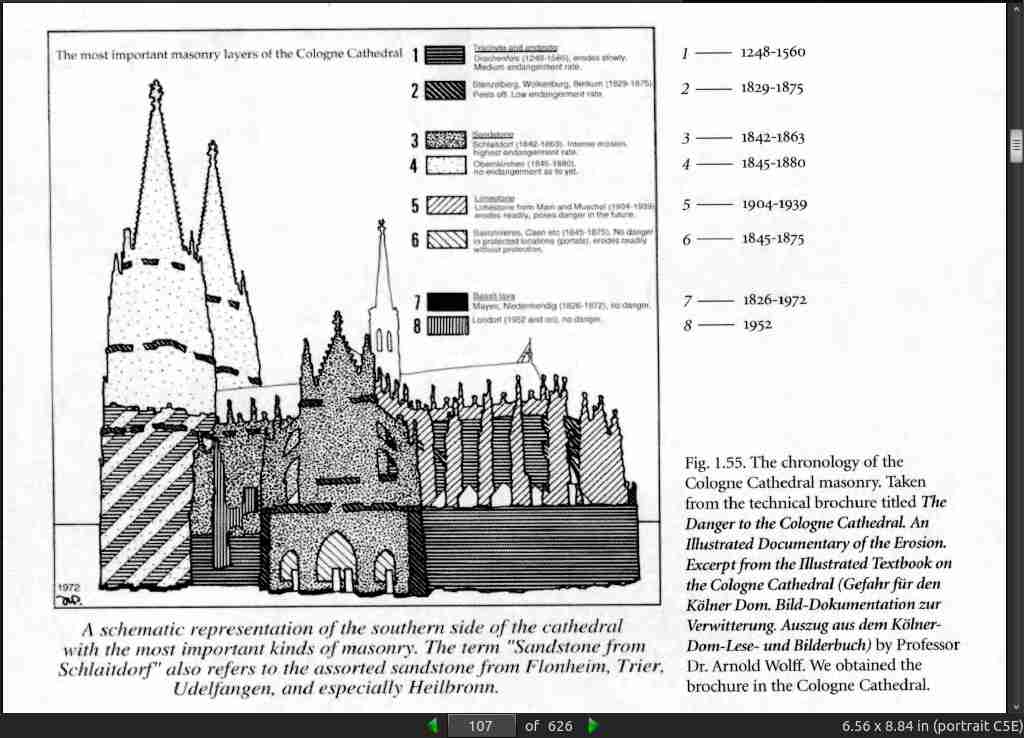
page 110:
- Scaligerian chronology places bronze before tin…
page 114:
- Radiocarbon dating was based on Scaliger’s datings. Radiocarbon is now known to have wild variations in measurements (up to several millennia).
page 120:
- The authors of the article [on a Mummy’s bones carbon dated to 1000BC and the wrap to 380AD] also confess to the fact that at the very dawn of the radiocarbon method “ancient” Egyption specimens had been used for its calibration, with their dates taken from history textbooks. Here’s a verbatim quote: ’the use of the method commenced in 1948 in Chicago University and was initiated by Professor W.F. Libby… the Egyptian chronology played a great role in the nascence of the method, since Egyptian specimens, such as wood or charcoal, among others, have been used as standards for the known historical dates.’ [1196]
page 127:
- Dendrochonology (measuring time via the rings of trees) is also suspect since trees grow at different rates in different regions and in different climates. There is also no way to set a verifiable scale since we can’t measure trees that are known thousands of years old (the best place we find ancient dead trees in Arizon, but that is no help dating European history).
page 131:
- “Ancient” coins were likely much newer. There is a gap, starting in the 8th century and running until about the 13th, where coins were not minted. They likely were minted, but have been dated older.
· Chapter 2: Astronomical Datings
page 140:
- Kepler has been in constant contact with Scaliger
page 146:

page 151:
- Our idea is as follows: the chronologies of the Scaliger-Petavius school first created the erroneous chronology of ancient and mediaeval history, having arbitrarily extended the real history of the 9-17th centuries AD into the past. After that, in the 16-17th centuries a great body of work was started in order to make this scheme “look scientific” as a result of astronomical calculations. If we’re to call a spade a spade, it really was a deliberate falsification of history.
page 173:
- The Scaligerian “astronomical solution” giving the lunar eclipse of the 3 April 33 AD as the moment of the crucifixion of Christ does not hold water whatsoever.
· Chapter 3: The Dating of the Astronomical Horoscope as Described in the Apocalypse
page 176:

page 177:

page 178:

page 179:

page 183:

page 184:

page 186:
-
“the first living creature was like a lion, the second was like an ox, the third had a face like a man, the fourth was like a flying eagle” (Apoc 4:7)
-
These creatures seem to be Leo, Taurus, Sagittarius, and Pegasus.
page 191:

page 192:

page 193:

page 195:

page 198:
- Book of Revelation/Apocalypse is dated via horoscope/planetary position to 1 Oct 1486.
page 200:
- 1486 falls in the epoch of the Ottoman/Ataman conquest.
page 201:
- Mediaeval Christians would have expected Judgement Day 7000 years after Adam. This would be 1492 AD.
page 203:

page 204:

page 205:
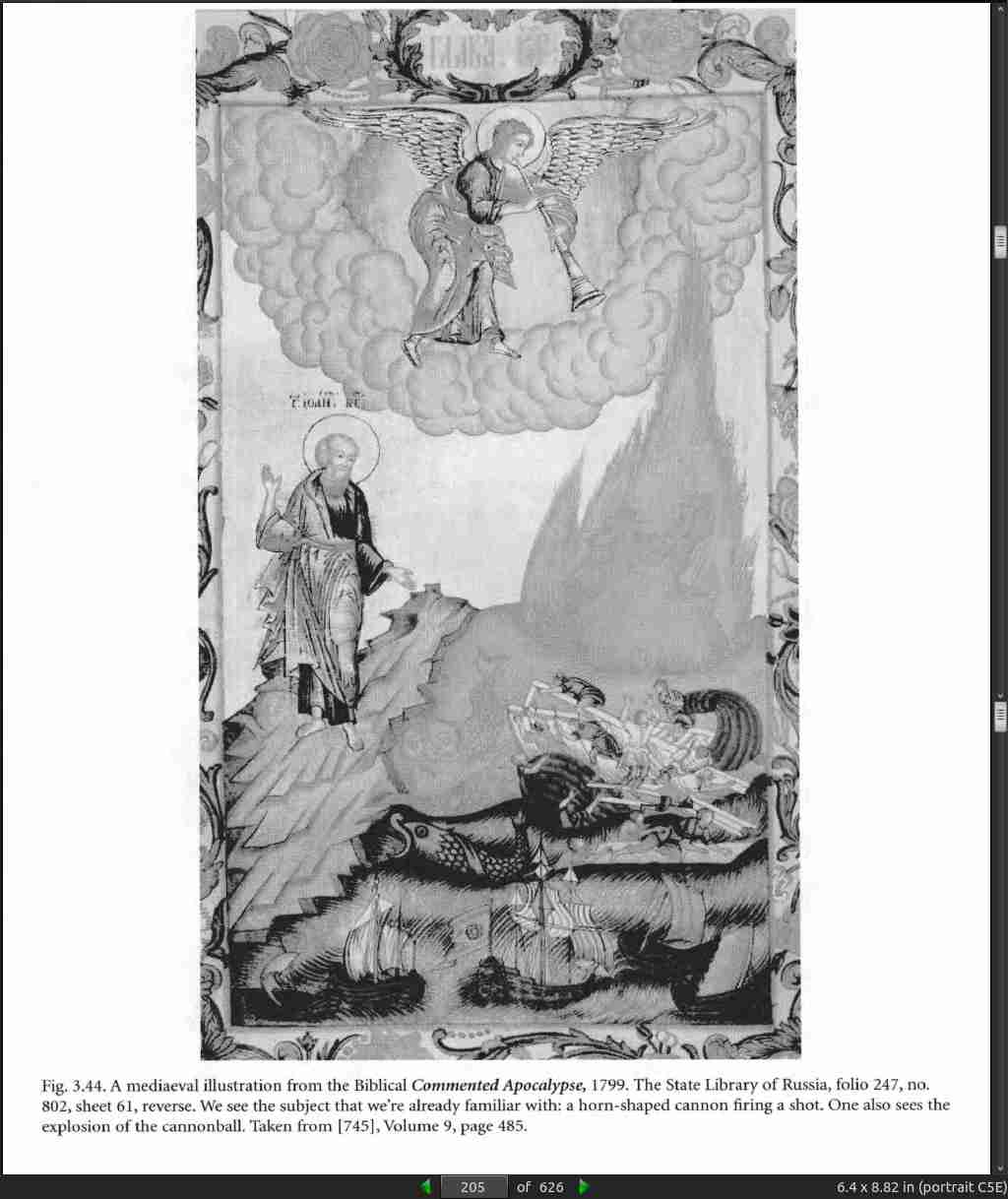
page 206:

· Chapter 4: Astronomy in the Old Testament
page 207:
- Our opinion is as follows: unlike the Apocalypse, the horoscope of Ezekiel is described extremely vaguely, and this ambiguous and Delphic description is hardly applicable to astronomical dating.
page 210:
- The first wheel, which is also the greatest, is the empyrean. The second wheel is the sphere of immobile stars. The third wheel is the celestial ocean. The wheels to follow are those of Saturn, Jupiter, Mars, the sun, Venus, Mercury, and the moon.
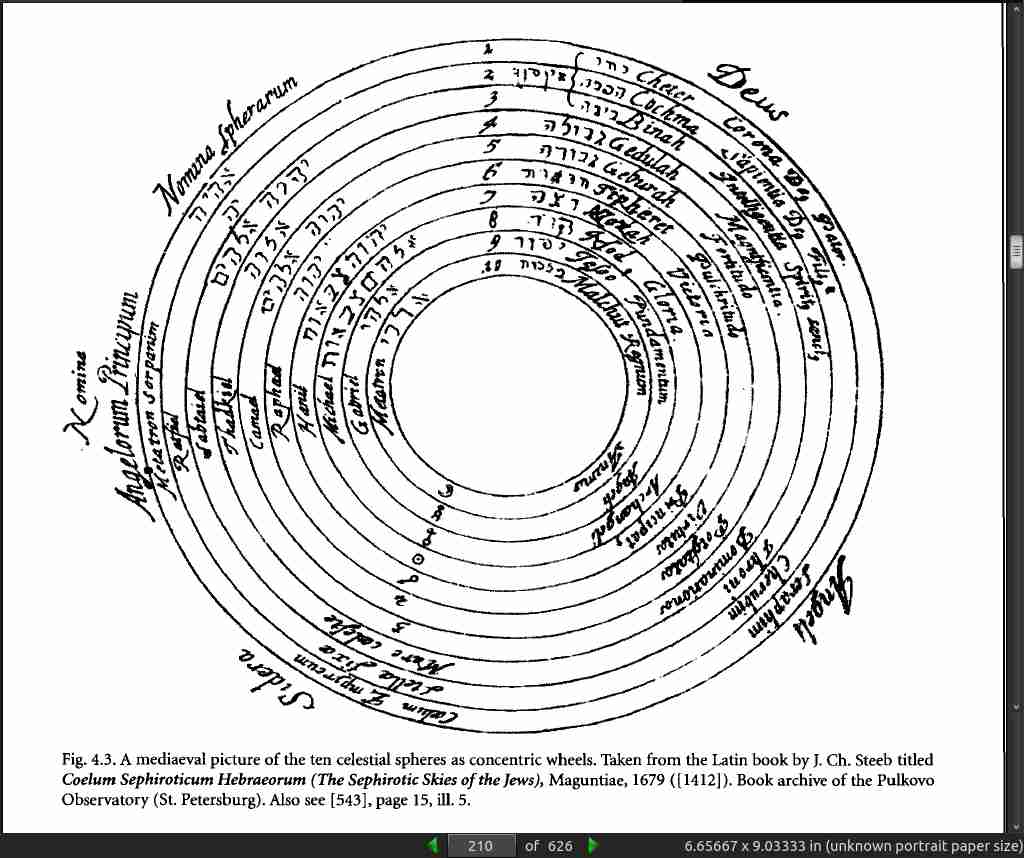
page 211:

page 215:

page 220:
- Zechariah 11:12-13, 11:17 and Matthew 26:15, 27:5-7 both tell stories about selling a person for 30 pieces of silver, and then casting them to the potter/potter’s field.
· Chapter 5: The Methods of Dating the Ancient Events Offered by Mathematical Statistics
page 230:
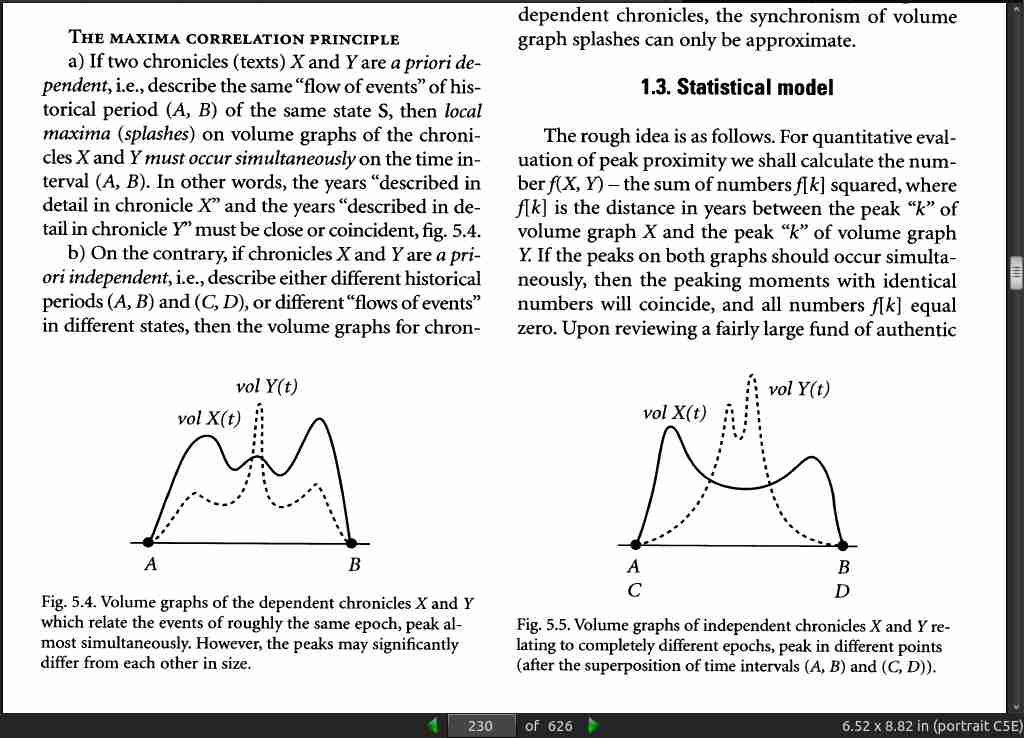
page 231:

page 243:
- Periods with “poor” availability of data should correlate between authors because they have such sparse information to go on. Periods with “rich” availability may not correlate because the authors can be more selective in their choice of covered topics.
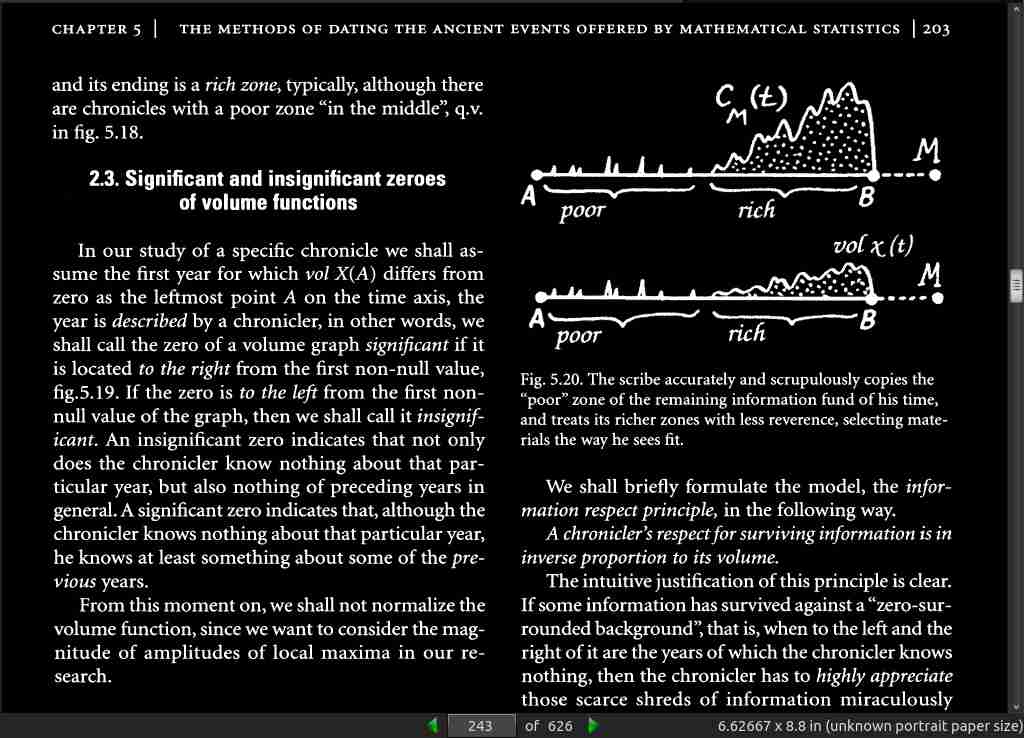
page 244:
- The amplitude of “poor” availability regions should also correlate since both authors will carefully copy all of the limited data from the given region.
page 246:

page 268:
- Generational “chapters” of the Old and New Testament.
page 278:
- The Roman and German dynasties of 15-20 biographies of kings proved to be dissimilar within Rome or Germany, but the Roman and German biographies appeared “amazingly similar” to one another.
page 287:

page 290:

· Chapter 6: The Construction of a Global Chronological Map
page 303:
- Simply speaking, “ancient” Rome and medieval Rome are probably the “same thing.”
page 304:

page 308:

page 309:

page 310:

page 312:

page 314:

page 316:

page 318:

page 320:

page 322:

page 324:

page 327:


page 330:

page 332:

page 334:

page 335:

page 339:
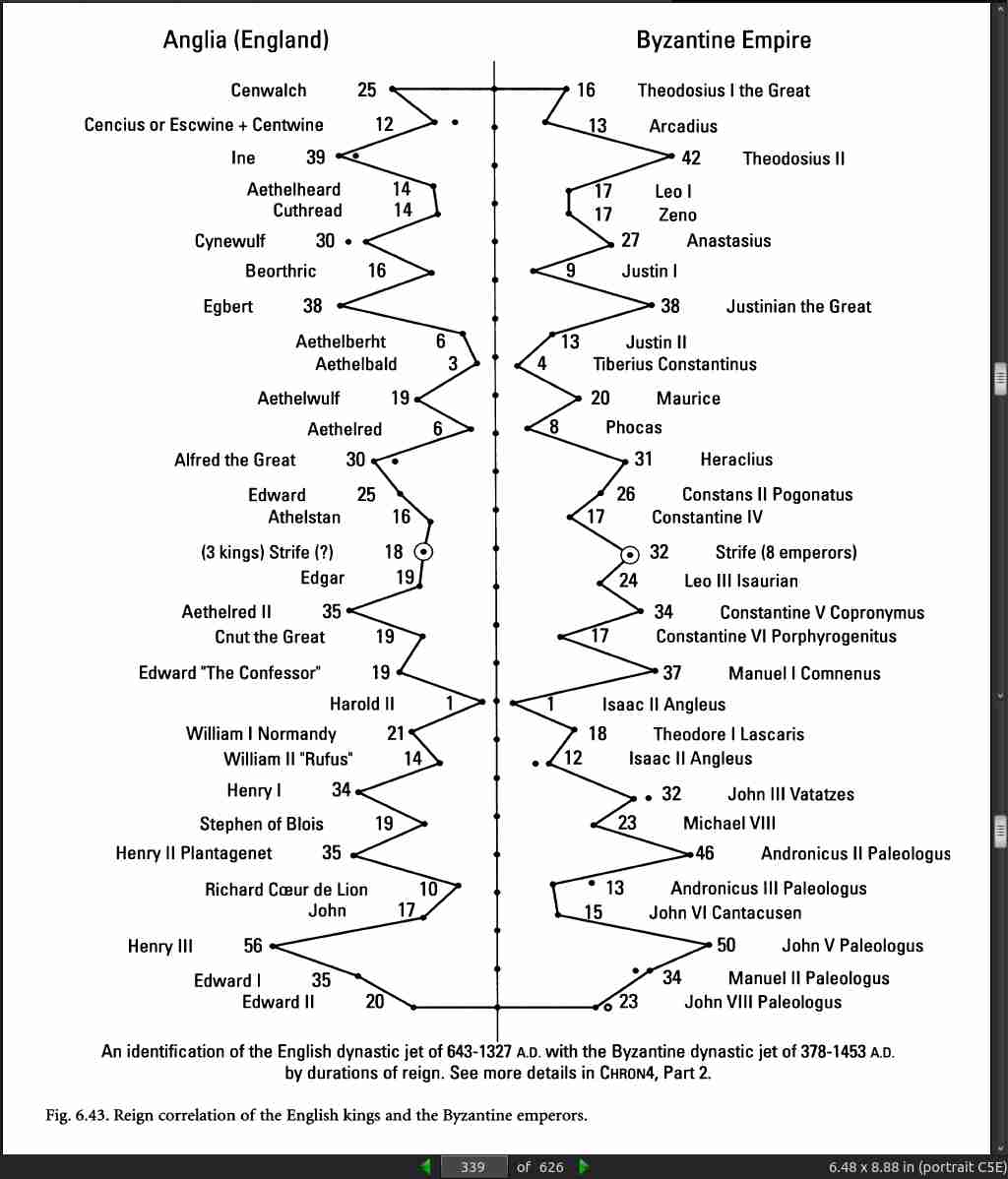
page 341:

page 343:

page 344:


page 345:

page 359:

page 360:
- the “Scaligerian textbook” on ancient and mediaeval history is the result of joining four virtually identical shorter chronicles, shifted by approximately 333, 1059, and 1800 years versus their mediaeval original.
page 362:
- [the shift] was probably the result of the activity of a well-known mediaeval chronologist Dionysius Petavius (1583-1652). He is “reflected in the past”, in particular, as Dionysius the Little, in the alleged 6th century A.D. It is interesting that our empirico-statistical mehtods had not revealed any statistical duplicates for the events which occurred after Dionysius Pentavius.

page 377:

page 378:
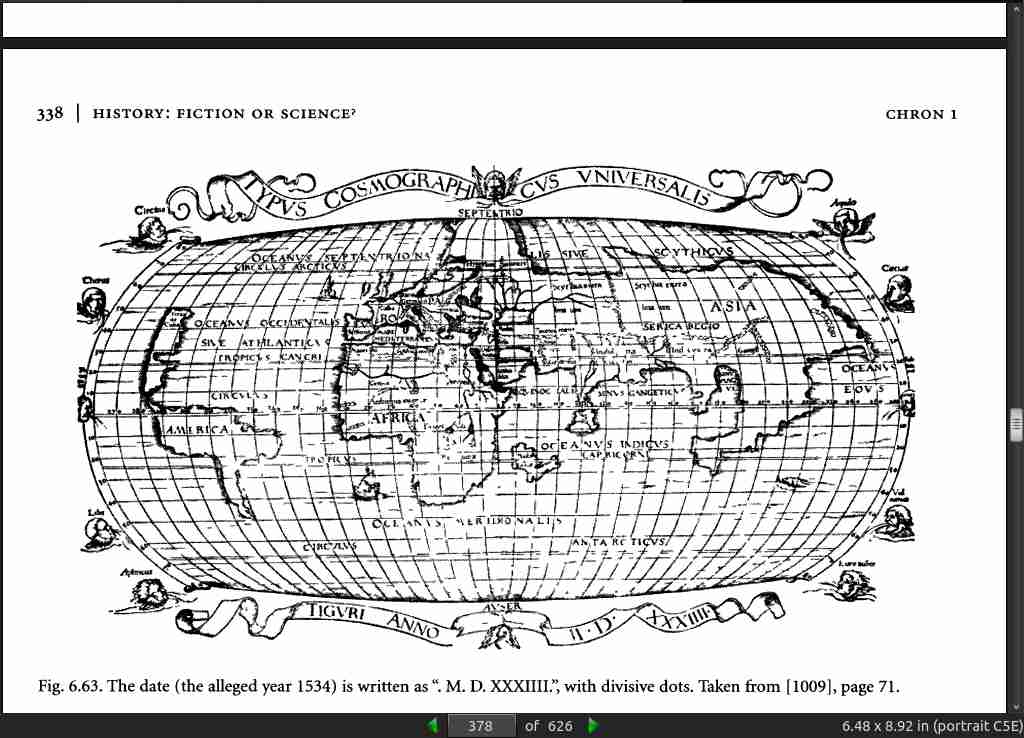

page 379:

page 371:
- the ‘chapters’ 1-137 of the Bible and the ‘Roman Chronicle’ X – are dependent.
page 373:
- In general, the outline for the global chronology of Europe was created in the 16-17th century, in the works of J. Scaliger and D. Petavius.
page 376:
- Roman numerals could have been misinterpreted for numbers, when they were actually abbreviations. Example: X could be an abbreviated from of XPICTOC (Christ in Greek). X.III would have then meant ’the 3rd century of/after Christ’ and not ’the 13th century’ as we read it today.
page 377:
-
The Latin letter “I” - the first one in Iesus, the Greek spelling of the nae Jesus – originally could be an abbreviated version thereof.
-
I.300/I300 would mean year 300 since Jesus.
-
The leading numbers of original documents have the first “large number” separated by dots.
page 380:

page 392:
- Some speculation regarding D,M,C.
D = Domini = Lord, Divine = Dom = House, Dynasty
M = Magnus, great
C = Caesar, kaiser, king
A.D. = Anno Domini = Years after the Lord
A.D.M. = Year of the Ruling House, Great Lord
M.D. = Great House
M.C. = Great King
C.M. = King Great
- The A, Anno, could have been dropped as it was understood.
page 401:
- 3 Dionysiuses, all chronologists. The first died in 265AD, the second D. Exiguus lived in 6th century AD, third D. Petavius (1583-1652).
page 402:
- Exiguus was known as D. the Little. Exigu = little in Latin. Petavius = petit in French.
page 407:

page 410:

page 411:

· Chapter 7: “Dark Ages” in Mediaeval History
page 418:
- F. Gregorovius, historian raised in Scaligerian tradition discovers the parallels between the Classical and the Middle Age that fits perfectly with Fomenko’s shifts.
page 419:
- St. Achilles, St. Quirinus, St. Dionysius, St. Hyppolitus, St. Hermesus. Saints or ancient gods and heros?
page 436:
- [Christian Bacchic celebrations may have occurred in the middle ages.] In “The Life and Activity of Balthazar Cossa (Pope John XXIII)” by Alexander Paradisis he writes “Nothing remained of the reclusion and the piety of the first centuries of Christianity, the decadency in the church and its morals attained grandiose proportions… The nuns’ clothing didn’t help austerity, either, since it served to emphasize their natural beauty and gracefulness… Nearly all Italian monasteries [according to Rodochanachi] allowed male visitors… As for Venetian monasteries – Casanova is not the only source of information in what regards those; St. Didier writes that ’nothing attracted as much interest in Venice as the monasteries.’ Noblemen have been frequent visitors there, too. Since all the nuns were beautiful and clean-limbed, none of them went without lover. The care of the dominae about the morals manifested as aiding the nuns in finding more elaborate ways of meeting their lovers and providing necessary alibis. During the Venetian carnival (which would last almost half a year over there), convents would turn into dance halls and become filled with masked men… The dresses have been narrow, fitting, tight around the waist, with large scoop neckline which demonstrated the white and voluptuous bodies of the nuns.” [see Rodocanachi “La Femme Tralienne, avant, pendate et apres la Resnaissance”, Paris 1922]
page 437:
- Charles Louis Polnitz writes that the Venetian nuns curled their hair, wore short dresses that failed to cover the svelte legs, and that their bosoms were only covered when they sang in church choir.
page 449:
- Obscene images, take from Pompeian painting and sculptures, kept in the museum Bourbon are in a special department that does not allow visitors.
- According to Humphrey Davy, “the Pompeian painters and the Italian painters of the Renaissance epoch used identical paints” [389, pg 70].
page 453:
- Petrarch can’t find any of the “ancient” Rome where it ‘should’ have been according to his books. The answer is that those books probably were referring to Constantinople.
page 457:
-
Petrarch wrote letters to the “Classical Age” because he loved it so much, not because they were his contemporaries.
-
Is Petrarch Plutarch?
-
F. Gregorovius talks about the “impenetrable darkness” surrounding Athens in the Middle Ages and that the city was so totally grown over by weeds and trees and burnt by barbarians that “hardly anything can serve as a more surprising proof of the city’s complete disappearance from the historical horizon than the very fact that one has to ‘prove the actual existence’ of what used to be one of the greatest cities in a country that is historical for the most part."
page 461:
-
Was Athena the Virgin Mary?
-
“The Christian religion had made the holiest place of the ancient goddess on the Acropolis [Parthenon] serve its ends almost without causing any hard to it… the entire history of transformation of ancient beliefs and holy places into Christian ones knows no other example of such easy and complete transformation as Athena Pallas had to undergo in order to become the Christian Blessed Virgin Mary… the Athenian populace didn’t even have to change the nicknames for its divine virgin protectrix, since the Blessed Virgin Mary retained the ancient name Parthenos” [195 pg 31]
page 471:

page 472:

page 474:
- There are many examples of Ottoman buildings…

page 475:
- Greek engineer Nikolaos Balanos “restored” the Parthenon in the late 19th to the 20th century. His assistant, Anastasios Orlandos broke off relations with him in 1922 when Balanos was supposedly building, not reconstructing, what he saw fit. Balanos would cut stones to make them fit his master plan and paid no attention to where they lay.

page 477:
